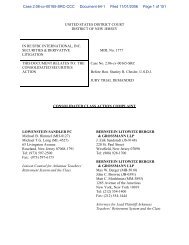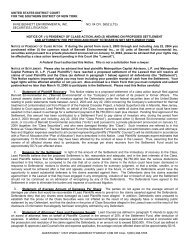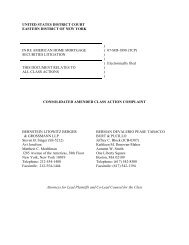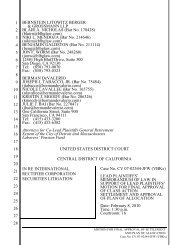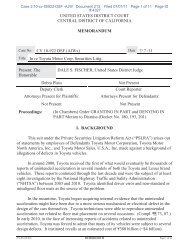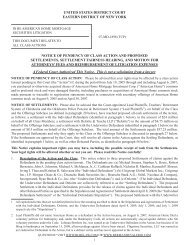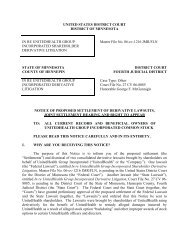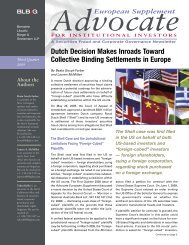to view the Lawdragon's - Bernstein Litowitz Berger & Grossmann LLP
to view the Lawdragon's - Bernstein Litowitz Berger & Grossmann LLP
to view the Lawdragon's - Bernstein Litowitz Berger & Grossmann LLP
Create successful ePaper yourself
Turn your PDF publications into a flip-book with our unique Google optimized e-Paper software.
500Lawdragon Q & A with:Vic<strong>to</strong>r SherMany laWYers enter <strong>the</strong> legal profession“<strong>to</strong> make a difference,” as is Vic<strong>to</strong>r Sher’s explanationfor his decision <strong>to</strong> attend law school. But few lawyerscan claim <strong>to</strong> have made such a massive impact throughlitigation, particularly in <strong>the</strong> area of environmental law.Sher of Sher Leff has devoted his life <strong>to</strong> protecting<strong>the</strong> environment, unafraid of taking on large corporationsand governmental agencies. He practiced atEarthjustice (previously known as <strong>the</strong> Sierra Club LegalDefense Fund) for more than a decade and served asits president from 1994 <strong>to</strong> 1997, where he litigatedand managed a staggering array of cases and campaigns.In private practice, he has focused his work onwater contamination cases. Sher won a $104.7M verdictin 2009 for <strong>the</strong> City of New York against ExxonMobil for contamination by MTBE.LAWDRAGon: When and why did you decide you wanted<strong>to</strong> devote your legal career <strong>to</strong> environmental law, asopposed <strong>to</strong> ano<strong>the</strong>r type of practice?vICTor SHER: I went <strong>to</strong> law school <strong>to</strong> make a difference,and started out working on a variety of publicinterest issues. I handled several pro bono cases in myfirst few years of practice involving civil rights, fairhousing and police misconduct. Then, in 1984, I representeda family farm in nor<strong>the</strong>rn California that facedlosing its organic certification - <strong>the</strong> foundation of <strong>the</strong>irbusiness - because <strong>the</strong> State of California intended <strong>to</strong>spray every apple, crabapple, and hawthorn tree or bushin six counties with a derivative of German nerve gas. Ofcourse, <strong>the</strong>re was an equally effective non-chemicalalternative. The case had everything that appealed <strong>to</strong>me: interesting legal and factual questions, challengingscientific issues, David v. Goliath, lots of media attentionand high drama. We got an injunction literally as<strong>the</strong> spray trucks were about <strong>to</strong> roll. I was hooked.LD: How did you come <strong>to</strong> get <strong>the</strong> job at Earthjustice?And what about <strong>the</strong> job kept you <strong>the</strong>re for more than adecade?VS: I originally volunteered <strong>to</strong> handle some overflowenvironmental cases out of <strong>the</strong> San Francisco office,while <strong>the</strong> organization was still known as <strong>the</strong> SierraClub Legal Defense Fund (although it was always independentfrom <strong>the</strong> Sierra Club). One of <strong>the</strong>se cases led<strong>to</strong> an injunction that preserved thousands of acres ofopen space on <strong>the</strong> coast from development; <strong>the</strong> propertylater became a state park. I got <strong>to</strong> know some of <strong>the</strong>senior management in San Francisco from working onthis and o<strong>the</strong>r cases. In 1986, <strong>the</strong> organization decid-bY John rYaned <strong>to</strong> open a new office in Seattle. I applied for andgot <strong>the</strong> job as managing at<strong>to</strong>rney. Then, following RickSu<strong>the</strong>rland’s untimely death in 1991 and an interregnumperiod, in 1993 I was drafted <strong>to</strong> become Presidentand moved back <strong>to</strong> San Francisco. In mid-1997 Iresigned <strong>to</strong> move in<strong>to</strong> private practice.I spent seven years in Seattle litigating cases forclean water, clean air, and <strong>to</strong> preserve <strong>the</strong> ancient forestsof <strong>the</strong> Pacific Northwest, among o<strong>the</strong>r cases.These were complex, high-profile cases, and <strong>the</strong>y wereexciting and satisfying <strong>to</strong> litigate. As President of <strong>the</strong>organization from 1993 <strong>to</strong> 1997, I was <strong>the</strong> CEO of a50-lawyer law firm with 10 offices around <strong>the</strong> country -<strong>the</strong> largest public interest environmental law firm in<strong>the</strong> world. I worked <strong>to</strong> increase our effectiveness bypromoting proactive litigation campaigns (ra<strong>the</strong>r thanjust individual cases) and expanding our capacity <strong>to</strong> beeffective political advocates in support of litigation.During my watch, we also adopted <strong>the</strong> Earthjusticename. The challenges of building an institution andrunning an organization were new <strong>to</strong> me and quite differentfrom litigating cases. But ultimately I missed<strong>the</strong> courtroom and left <strong>to</strong> do environmental <strong>to</strong>rt cases.LD: Obviously, <strong>the</strong>re were many cases you worked on at<strong>the</strong> organization, as you just discussed. Never<strong>the</strong>less,is <strong>the</strong>re a case or type of litigation you handled thatyou think really stands out in terms of <strong>the</strong> legacy youleft for <strong>the</strong> organization, a particular region or <strong>the</strong>environment generally?VS: Probably <strong>the</strong> best known of my Earthjustice caseswere <strong>the</strong> multiple series of lawsuits my colleagues and Ibrought over <strong>the</strong> nor<strong>the</strong>rn spotted owl, which was a keyindica<strong>to</strong>r species for <strong>the</strong> health of <strong>the</strong> ancient forests of<strong>the</strong> Pacific Northwest. These cases exposed what onecourt called a remarkable series of violations of <strong>the</strong> federalenvironmental laws by <strong>the</strong> federal agencies chargedwith protecting <strong>the</strong>se lands and species, and led <strong>to</strong> aseries of injunctions issued by multiple courts underseveral laws that changed logging practices on millionsof acres. The American Lawyer called <strong>the</strong>se casesamong <strong>the</strong> most significant public lands cases in <strong>the</strong>nation’s his<strong>to</strong>ry, and <strong>the</strong>y led <strong>to</strong> a wholesale revision of<strong>the</strong> way <strong>the</strong> U.S. Forest Service and <strong>the</strong> Bureau of LandManagement manage biodiversity on federal lands.I found litigating <strong>the</strong>se cases fascinating bothbecause of <strong>the</strong> important legal and biological issues,and also because <strong>the</strong>y played out on multiple legal andpolitical levels. See <strong>the</strong> full Q&A at www.lawdragon.com/lawyer-limelights/vic<strong>to</strong>r-sher.L A W D R A G O N 162 I s s u e 13 Pho<strong>to</strong> by: Gregory Cowley



